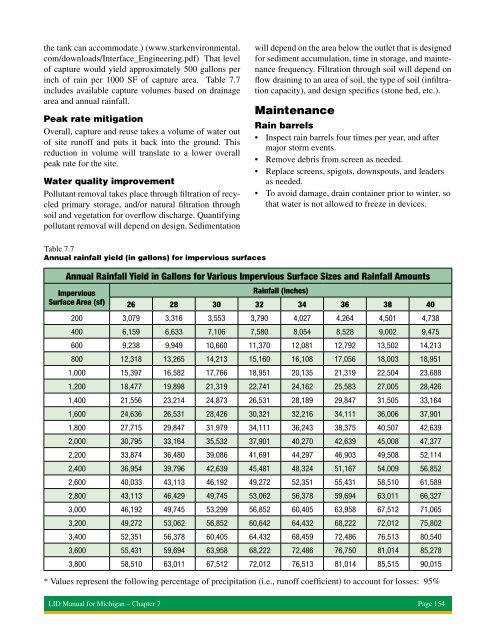Low Impact Development Manual for Michigan - OSEH - University ...
Low Impact Development Manual for Michigan - OSEH - University ...
Low Impact Development Manual for Michigan - OSEH - University ...
You also want an ePaper? Increase the reach of your titles
YUMPU automatically turns print PDFs into web optimized ePapers that Google loves.
the tank can accommodate.) (www.starkenvironmental.<br />
com/downloads/Interface_Engineering.pdf) That level<br />
of capture would yield approximately 500 gallons per<br />
inch of rain per 1000 SF of capture area. Table 7.7<br />
includes available capture volumes based on drainage<br />
area and annual rainfall.<br />
Peak rate mitigation<br />
Overall, capture and reuse takes a volume of water out<br />
of site runoff and puts it back into the ground. This<br />
reduction in volume will translate to a lower overall<br />
peak rate <strong>for</strong> the site.<br />
Water quality improvement<br />
Pollutant removal takes place through filtration of recycled<br />
primary storage, and/or natural filtration through<br />
soil and vegetation <strong>for</strong> overflow discharge. Quantifying<br />
pollutant removal will depend on design. Sedimentation<br />
Table 7.7<br />
Annual rainfall yield (in gallons) <strong>for</strong> impervious surfaces<br />
Annual Rainfall Yield in Gallons <strong>for</strong> Various Impervious Surface Sizes and Rainfall Amounts<br />
Impervious<br />
Surface Area (sf)<br />
will depend on the area below the outlet that is designed<br />
<strong>for</strong> sediment accumulation, time in storage, and maintenance<br />
frequency. Filtration through soil will depend on<br />
flow draining to an area of soil, the type of soil (infiltration<br />
capacity), and design specifics (stone bed, etc.).<br />
Maintenance<br />
Rain barrels<br />
• Inspect rain barrels four times per year, and after<br />
major storm events.<br />
• Remove debris from screen as needed.<br />
• Replace screens, spigots, downspouts, and leaders<br />
as needed.<br />
• To avoid damage, drain container prior to winter, so<br />
that water is not allowed to freeze in devices.<br />
Rainfall (inches)<br />
26 28 30 32 34 36 38 40<br />
200 3,079 3,316 3,553 3,790 4,027 4,264 4,501 4,738<br />
400 6,159 6,633 7,106 7,580 8,054 8,528 9,002 9,475<br />
600 9,238 9,949 10,660 11,370 12,081 12,792 13,502 14,213<br />
800 12,318 13,265 14,213 15,160 16,108 17,056 18,003 18,951<br />
1,000 15,397 16,582 17,766 18,951 20,135 21,319 22,504 23,688<br />
1,200 18,477 19,898 21,319 22,741 24,162 25,583 27,005 28,426<br />
1,400 21,556 23,214 24,873 26,531 28,189 29,847 31,505 33,164<br />
1,600 24,636 26,531 28,426 30,321 32,216 34,111 36,006 37,901<br />
1,800 27,715 29,847 31,979 34,111 36,243 38,375 40,507 42,639<br />
2,000 30,795 33,164 35,532 37,901 40,270 42,639 45,008 47,377<br />
2,200 33,874 36,480 39,086 41,691 44,297 46,903 49,508 52,114<br />
2,400 36,954 39,796 42,639 45,481 48,324 51,167 54,009 56,852<br />
2,600 40,033 43,113 46,192 49,272 52,351 55,431 58,510 61,589<br />
2,800 43,113 46,429 49,745 53,062 56,378 59,694 63,011 66,327<br />
3,000 46,192 49,745 53,299 56,852 60,405 63,958 67,512 71,065<br />
3,200 49,272 53,062 56,852 60,642 64,432 68,222 72,012 75,802<br />
3,400 52,351 56,378 60,405 64,432 68,459 72,486 76,513 80,540<br />
3,600 55,431 59,694 63,958 68,222 72,486 76,750 81,014 85,278<br />
3,800 58,510 63,011 67,512 72,012 76,513 81,014 85,515 90,015<br />
* Values represent the following percentage of precipitation (i.e., runoff coefficient) to account <strong>for</strong> losses: 95%<br />
LID <strong>Manual</strong> <strong>for</strong> <strong>Michigan</strong> – Chapter 7 Page 154

















